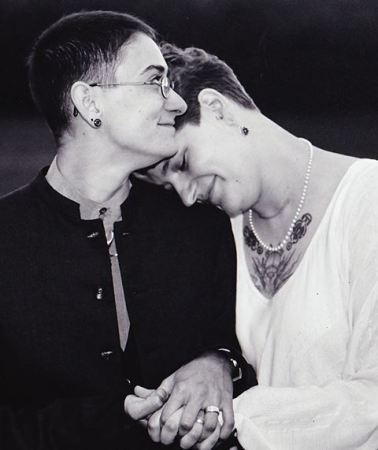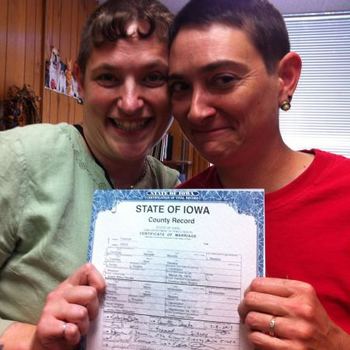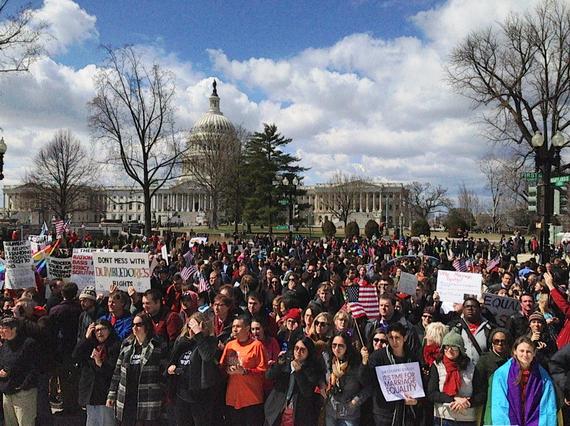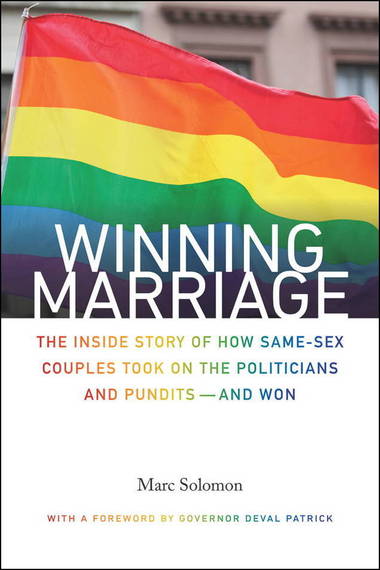When a Real Kansas Marriage Turns Into a Legal One

When Courtney and Denise asked me to marry them, I said, “Sure, but you know, I’m not legal to marry anyone.”
“Duh,” said Denise, giggling.
“Like it matters,” added Courtney.
At the time, in early 2001, gay marriage was so small a glimmer of possibility, something we all thought might happen in our lifetime, maybe when we were passing around pictures of our grandchildren. Making do without being able to make up for this injustice was all we had.
We got to know Denise in her job at Free State Credit Union and through the Merc, and Courtney when she was a para for our oldest son when he was in fifth grade. Over the 1990s, we become close friends, the kind who can take naps on one another’s couches or leave a dinner conversation to do something on the computer for work, no explanation needed. It was as if we had been family for decades before we actually met, and we hang out together, in I Love Lucy terms, not like Ricky, Lucy, Fred and Ethel, but more like Ricky and three Lucys.
So on May 6, 2001, we gathered at Ken’s and my house south of Lawrence and gleefully paraded with family and friends alongside the woods to the southeast corner of a field. Denise was crying and swirling in her wide-swinging white dress, while Courtney was laughing and rolling her eyes. They held hands, looked at each other, Denise giggling and crying at once, as they came to the exact place where I would marry them.
So of course I could be a pretend rabbi, acting in faith that this was a real marriage, and one day the world would catch up to Courtney and Denise. They had been together for years, and all of us had just been through Denise’s thyroid cancer together when Courtney had to endure the insult of fighting to see her beloved in the hospital because they were both women.
The wedding happened at dusk in a slim gap of sunlight on an afternoon of rain. The whole wedding party stood in a circle around the bride and bride, my daughter Natalie excited to be ring bearer in her white pants and rainbow shirt, my sons and husband wrapped close, smiling and crying with joy like all the other guests there.
In the 13 years since the not-real real wedding, Courtney and Denise had a son, Marek, born during a very joyous if long labor at the Topeka Birthing Center. Denise decided to become a nurse, and after two years of prerequisite classes, she got accepted into the prestigious nursing program at Baker University, graduated with flying colors, and now works at Stormont-Vail Medical Center. Courtney was finally able to leave her job at the post office to throw her immense energy into Homestead Ranch, where they raise goats, chickens and other critters; grow immense amounts of vegetables; and handcraft the best goat-milk soaps and lotions on the planet. Marek is close to 10 years old and excels at karate and making holiday ornaments to sell at the farmer’s market, and he plays a mean game of Apples to Apples. The whole family has run a booth at the farmer’s market, waking in the dark and wee hours every Saturday from May through November, for years, and cater to a loyal following.
A family business and farm. A child and his education. A home full of dogs, cats and tree frogs. A rich life with plenty of bouts of Guitar Hero and other games to play together. Spectacular turkey dinners with all the trimmings on Thanksgiving and beyond. And now land where they plan to build their dream house in coming years.
Throughout the years, we’ve come to know each other’s extended families and shared the sorrow of a close friend’s sudden passing and the loss of fathers and mothers, birthday parties and bar mitzvahs, and an outrageous amount of spaghetti-and-meatball dinners. Those in our family who, at first, had complaints about a lesbian couple, like much of America, softened their position over the years, eventually dissolving away such complaints. Courtney and Denise effectively, simply by being who they are and being around, changed the minds of people in our extended families as well as people they met through work, kids’ activities and the farmer’s market, about gay rights.
Yet it took until July 2013 for Courtney and Denise to get legally married, and they had to travel out of state to Sidney, Iowa, for the ceremony because our home state doesn’t recognize marriage between two women. They also had to work long and hard to get Courtney covered on Denise’s health insurance, and they still can’t file taxes jointly. Our dear friends live and love a lot like us, yet they have to wait in the background for the light of equality to slowly reach them and other-than-hetero-identified people.
The butt of most jokes in the ’70s, when I was growing up, was either gay men or Poles, and the word “lesbian” was so exotic and hushed-up that it seemed utterly mythological. For years, I’ve watched gay, lesbian and, in the last decade, trans friends struggle with how much of themselves to hide, who not to tell, how to say it to those they felt they could tell, and, moreover, the damaging weight of our societal silencing and shaming of them.
The advancement of gay marriage has moved a million times faster than I ever dreamed when I was growing up, watching gay or lesbian friends or acquaintances cast as exotic at best, repugnant at worst. Yet when it comes to my friends and so many other Kansans who have waited years, decades, lifetimes, to be able to simply say “my wife” or “my husband” and reap other legal, economic, religious and social benefits, the wait is excruciatingly slow.
When it comes to my beloved and chosen home state of Kansas, where I’ve lived since 1983, in love with the big sky’s parade of weather and color, I couldn’t imagine marriage equality landing here until the end of its reign across the rest of America. Kansas is one of the reddest of red states, where so many very good people continue to vote into office extremist right-wing politicians who work against the needs, hopes and dreams of these good people, so it’s no wonder that my friends and I would regularly joke about whether Kansas would be the 49th or 50th state to stand on the side of the love. Strangely and wonderfully enough, thanks to the court systems, an excellent marriage-equality campaign here, and the down-home common sense of most Kansans, here we are, gay and lesbian marriages happening in mid-November right here in the heartland.

Soon Courtney and Denise’s marriage in Iowa will be recognized in Kansas, but for now, they, along with other couples, are battling to get the tax refund they are due from filing jointly last year. The courts in Kansas are also active with confusion and warring arguments about when to recognize the legal marriages of gay and lesbian couples who are marrying right now in Kansas or have already married out of state, such as Courtney and Denise. As has gone the way of marriage equality in all other states where it is now recognized, we know that in the next several weeks or months, Kansas will not be the 49th state to embrace marriage equality but probably the 30th-something state.
In the meantime, 13 years after Courtney and Denise vowed to love each other with all their heart and soul for their lifetimes, we’re talking about a party, long unimaginable and longer overdue, to celebrate the love of justice and the justice of love.
www.huffingtonpost.com/caryn-mirriamgoldberg/when-a-real-kansas-marria_b_6161394.html?utm_hp_ref=gay-voices&ir=Gay+Voices








